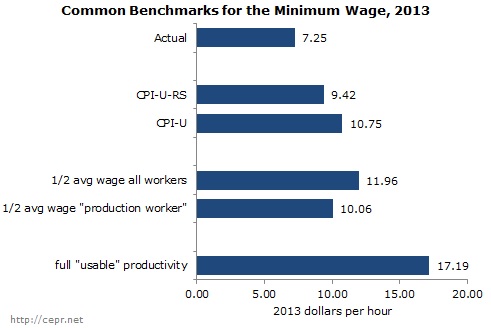July 17, 2013
July 24th will mark four years since the last increase in the federal minimum wage. By the most commonly used benchmarks – inflation, average wages and average productivity – the current $7.25-an-hour rate is well below the peak it hit five decades ago.
According to these benchmarks, the federal minimum wage peaked in 1968. If it had been indexed to the official Consumer Price Index (CPI-U) from that point forward, the minimum wage in 2013 would be $10.75 — $3.50 per hour higher than it actually is. If we measure inflation from 1968 forward using the same procedure we use today (the way we calculate inflation has been updated several times since the late 1960s), the 2013 value of the minimum wage would be $9.42 (see the figure below) — almost $2.25 higher than it is today.

During much of the 1960s, the minimum wage was close to 50 percent of the average production worker’s earnings. At its 1968 peak, the minimum wage was equal to 53 percent of what the average production worker made. If the minimum wage were at 50 percent of the production worker wage in 2013 (using a projection of the 2012 level to produce a full-year 2013 estimate), the federal minimum would be $10.06 per hour.
If we were to set the minimum wage at one-half of the average of what all workers make (that is, if we also include the 20 percent of workers that work in typically better paid non-production and supervisory jobs), then the minimum wage would be almost $12.00 per hour in 2013.
A final benchmark for the minimum wage is productivity growth. From its creation in 1938 through the end of the end of the 1960s, the minimum wage grew at the same pace as overall productivity growth in the economy. In the past several decades, however, productivity has far outpaced the minimum wage. If the minimum wage had continued to move since 1968 in line with what our CEPR colleagues call “usable productivity” (which for technical reasons has grown more slowly than productivity as conventionally measured), the minimum wage would be $17.19 per hour in 2013, nearly two and half times its current value.
As we noted in an earlier post, even if the cost of living had not changed between the 1960s and today, we would have expected workers at the bottom to have higher wages today because they are much older and much better educated than low-wage workers were in earlier decades.
Notes
Data for full-year 2013 consumer price index and productivity are based on Congressional Budget Office (CBO) projections for 2013, from CBO, The Budget and Economic Outlook: Fiscal Years 2013 to 2023, Tables 2-1 and 2-2, http://www.cbo.gov/sites/default/files/cbofiles/attachments/43907-BudgetOutlook.pdf







